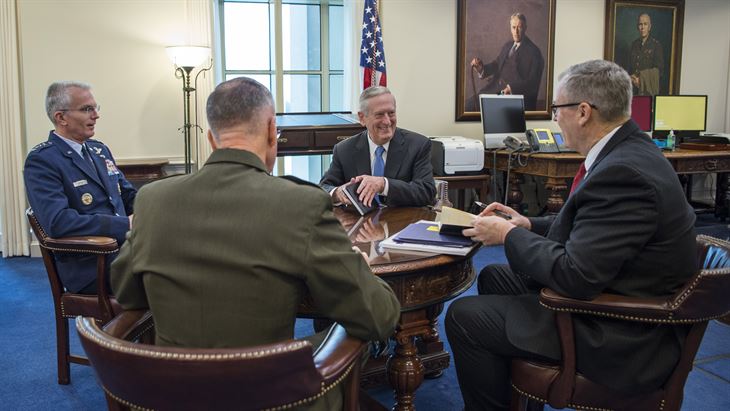Mattis Puts Readiness First, Modernization Later In Budget
Posted on

Defense Secretary James Mattis at his first meeting at the Pentagon. Deputy Secretary Bob Work is on the right (Mattis’s left).
WASHINGTON: Defense Secretary Jim Mattis has laid out a measured and cautious spending plan that puts near-term readiness needs first in his first budget guidance memo. The memo, out this morning, largely defers major equipment modernization until 2019 and limits increases in the size of the force to “the maximum responsible rate” (emphasis ours). So, while Trump may yet launch a Reaganesque build-up of the military, the memo makes clear that it won’t start right away. It’s also explicit that, alongside straight additions to the budget, there will be “efficiencies” and cuts.
Budget Guidance Memo by BreakingDefense on Scribd
Overall, much like Mattis’s public statements on everything from foreign allies to the F-35 fighter, the budget memo is less revolutionary and more consistent with Obama Administration policies than is President Trump’s fiery rhetoric. “I can envision (former Defense Secretary Ash) Carter signing the same memo, if he was given a higher top line,” said one Hill staffer. In particular, priorities such as “enhancing the lethality of the joint force against high-end competitors” — Pentagon jargon for China and Russia — align perfectly with Carter’s plans. What’s more, while Carter is gone, his deputy Bob Work remains, and the memo charges Work with the lead role in preparing both the Pentagon’s proposed amendments to the 2017 budget and its budget request for 2018.
Admittedly, Mattis’s memo includes no numbers. “The dollar figures are something OMB would establish/approve,” a Pentagon spokesperson confirmed to me this morning — and the Office of Management & Budget will presumably be headed by a hardcore fiscal hawk, Rep Mick Mulvaney. But the memo does set broad priorities and specific dates:
- By March 1st, the Pentagon will give OMB its requested amendments to the 2017 budget. The focus will be “urgent warfighting readiness shortfalls” and “the acceleration of the campaign against ISIS,” the memo says, with any force structure increases limited to ones with “an immediate readiness impact” (e.g. maintenance crews). There’s no mention of modernization in this phase. There is mention of cuts from unidentified “lower priority programs” to help pay for readiness increases. That said, the amendment overall will be a “net increase” over the Obama request, though it’s unclear how this net increase will be paid for: Putting it the base budget would require overriding the Budget Control Act, while putting it in Overseas Contingency Operations (OCO) would infuriate budget hawks who see that as a dodge.
- By May 1st, the Pentagon will give OMB its proposed 2018 budget, which suggests the budget won’t be finished and made public until May or even June. The focus here will be “balancing the program, addressing pressing programmatic shortfalls (e.g. modernization), while continuing to build readiness.” The examples given range from funding demonstrations of advanced technologies — but not necessarily buying them in bulk — to improving the upkeep of DoD facilities (long a bill-payer for other priorities) and “growing force structure at the maximum responsible rate.” “Responsible” in this case probably means ensuring that any troop increase is accompanied by funding to train, maintain, and equip them; top brass have repeatedly warned increasing endstrength but not readiness will just create a 1970s’ style “hollow force.”
- In 2018, the Pentagon will produce a National Defense Strategy and a spending plan (FYDP) for 2019-2023. This is where the focus turns from readiness to the build-up. The National Defense Strategy will set force “a new force sizing construct” — perhaps a return to the old standard of being able to fight two wars at once. To make that a reality, the plan will “grow the force quickly but responsibly” — again, implying readiness funds will rise in proportion to endstrength. It’s this phase of the plan that emphasizes modernization, calling for “critical investments in advanced capabilities” and “enhancing the lethality of the joint force against high-end competitors,” all very much in line with Carter’s long-term plans. It also calls for continued efficiencies, promising “an ambitious reform agenda, which will include horizontal integration across DoD components” — perhaps consolidating such support functions as medical care currently provided separately by the services.

USS Ronald Reagan
Less Than Reaganesque
The one surprise in the Mattis memo is “the explicitly stated objective of building a long-term defense plan to counter high-end threats,” said Mackenzie Eaglen of the American Enterprise Institute. While Carter & co. focused intently on countering Russia and Chinese advances, she said, “the prioritization of these competitions was always a question mark for Team Trump, so it is a positive indication that Bob Work and others are wisely influencing the incoming group to take seriously other challenges in addition to terrorism.”

Mackenzie Eaglen
That said, “it’s clear this is a readiness first-and-always endeavor,” Eaglen said. “Next up
is in priorities is a bigger force, personnel-wise. Lastly, if there is time and money left over, will be some select modernization of equipment. Even when additional capability is pursued, it is likely to be more a series of ‘small ball’ efforts like growing munitions stockpiles than sizeable increases in inventory of new aircraft and next-generation vehicles a la Reagan buildup.”
There’s not going to be an immediate “procurement shopping spree,” agreed Katherine Blakely of the Center for Strategic & Budgetary Assessments. Instead, the Mattis plan takes time to develop more advanced capabilities, particularly in the repeatedly-mentioned area of “lethality.”

Katherine Blakeley
What does that mean? Future adversaries may be markedly more deadly, Blakeley says, which force the US to make its forces more lethal to match. Greater lethality also argues against over-investing in a small number of expensive, “exquisite” superweapons that can be taken down with a few good hits. (Think of the Death Star in Star Wars for the extreme example). The crucial “leading indicators” to watch, she said, will be whether the forthcoming budget emphasizes upgrading the lethality of existing systems — new missiles for old ships, for instance — and whether funding is forthcoming for the high-tech experiments of Carter’s Strategic Capabilities Office and Third Offset Strategy — Bob Work being the principal architect of offset since the start.
The Mattis memo definitely has a lot in common with Carter than Trump’s rhetoric would lead one to expect, said defense industry analyst Byron Callan. Candidate Trump focused on “let’s just buy more big platforms,” especially ships, Callan told me. The Mattis plan is much more focused on targeted investments in lethality, which implies investing in superior smart weapons, and the sensors and networks that guide them, rather than new planes, ships, and tanks to carry them.

Byron Callan
Of course, the ultimate problem is how to pay for it all. “This is not going to be open-ended growth for the Department of Defense,” warned Callan. Even the legendary Reagan buildup slowed after the first four years, in part because of concerns over rising debt. The Trump buildup could go the same way.
If you’re not careful, “these macroeconomic factors kind of cut you off at the knees,” said Callan. “If you juice this thing (defense spending) and you don’t get the GDP growth that you’re hoping for, or interest rates conspire against you… that’s going to cut off this growth and these great plans for 355-ship navies and fifth-generation Air Force fleets.”
Subscribe to our newsletter
Promotions, new products and sales. Directly to your inbox.
